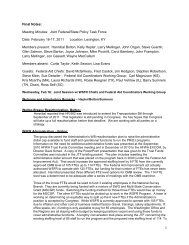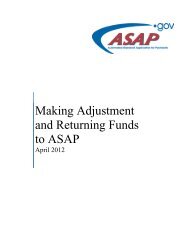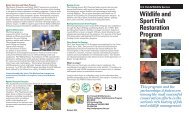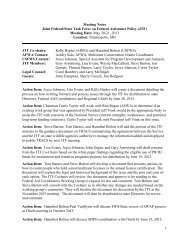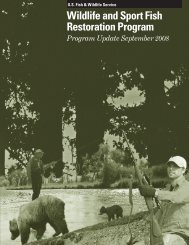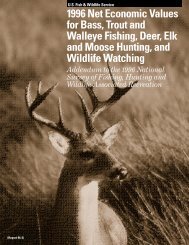Financial Returns To Industry From The Federal Aid - Wildlife and ...
Financial Returns To Industry From The Federal Aid - Wildlife and ...
Financial Returns To Industry From The Federal Aid - Wildlife and ...
You also want an ePaper? Increase the reach of your titles
YUMPU automatically turns print PDFs into web optimized ePapers that Google loves.
<strong>The</strong> program creatively used the antlered (bull <strong>and</strong> buck) <strong>and</strong> antlerless tags the UDWR<br />
was issuing as incentives for private l<strong>and</strong>owners to open up their l<strong>and</strong> for public hunting.<br />
Prior to the creation of the CWMU program, the agency was having difficulty meeting its<br />
big-game population objectives in many game-management units that were<br />
predominantly private l<strong>and</strong>s.<br />
<strong>The</strong> CWMU program permitted the UDWR to allow qualified l<strong>and</strong>owners to sell biggame<br />
tag vouchers directly to hunters at whatever price the market would support. <strong>The</strong><br />
vouchers were redeemable at the UDWR for big-game tags.<br />
In return for this important economic incentive, the private l<strong>and</strong>owners had to agree to<br />
allow the public access to their l<strong>and</strong>. In addition, a certain percentage of both antlered<br />
<strong>and</strong> antlerless tags were reserved for public drawings at their face value. In 2009, 2,700<br />
bull <strong>and</strong> buck tags <strong>and</strong> 1,500 antlerless tags were issued through the program.<br />
<strong>The</strong> precise allocation of the tags varies with the wildlife-management option that<br />
individual l<strong>and</strong>holders select. However, approximately 80 % of the bull tags are sold<br />
through the cooperating l<strong>and</strong>owners to resident <strong>and</strong> non-resident hunters, <strong>and</strong><br />
approximately 80% of the antlerless tags are available to resident hunters via public<br />
drawings. <strong>The</strong> dem<strong>and</strong> for these tags remains high, <strong>and</strong> in many of the popular units it<br />
may take several years to draw a tag. <strong>The</strong> tag vouchers sold by cooperating l<strong>and</strong>owners<br />
can be purchased annually <strong>and</strong> are available based on market conditions.<br />
<strong>To</strong> qualify to participate in the CWMU program, l<strong>and</strong>owners had to meet minimum<br />
acreages <strong>and</strong> have a wildlife-management plan. <strong>The</strong> minimum l<strong>and</strong> holding needed to<br />
participate in the deer <strong>and</strong> antelope program is 5,000 acres. This increases to 10,000<br />
acres for participation in the elk <strong>and</strong> moose program. In many situations, adjacent<br />
l<strong>and</strong>owners pool their l<strong>and</strong>s in order to qualify. In 2009, approximately 2.1 million acres<br />
of private l<strong>and</strong> was enrolled in the program <strong>and</strong> opened to public hunting.<br />
<strong>The</strong> wildlife-management plans were cooperatively developed between the UDWR <strong>and</strong><br />
the l<strong>and</strong>owners. <strong>The</strong>y included population goals, permit numbers <strong>and</strong> allocations, as<br />
well as habitat-improvement programs. Each plan is updated annually. <strong>The</strong> program is<br />
working so well that many l<strong>and</strong>owners are now including wildlife in their ranching<br />
operational plans.<br />
UDWR's investment has averaged approximately, $150,000 of <strong>Wildlife</strong> Restoration<br />
funds matched with $50,000 of state funding each year since 1993 14 . This investment<br />
consists largely of the staff time biologists devote to developing <strong>and</strong> updating the<br />
wildlife-management plans.<br />
As a result, in 2009, approximately 11,655 hunter-days were generated by bull <strong>and</strong> buck<br />
tag holders <strong>and</strong> 7,500 hunter-days were generated by antlerless tag holders. In years<br />
past, Utah has issued up to at least 3,500 bull <strong>and</strong> buck tags as well as 3,000 antlerless<br />
14 It is important to note that, as part of a larger comprehensive management project, Utah’s CWMU programmatic<br />
tracking of investments provides only an estimate of funds invested.<br />
41



